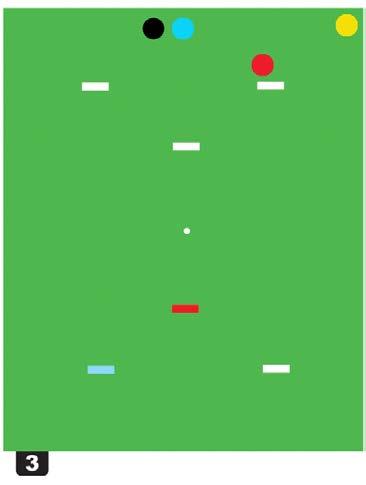
3 minute read
Let's Talk Tactics
The Inner Battle
By Bob Kroeger and John C. Osborn
No matter how long you have been playing croquet or no matter where your handicap might stand, odds are an invisible battle is bubbling beneath your skin. Don’t worry; this is not your fault. In fact, it is this inner battle that makes the game fascinating, a conflict that will always exist and always be in flux. Are my skills good enough to do what I would like, or could I do more with the skills I have?
Players generally fall into one of two categories: 1) those who can attack effectively and run breaks for several wickets and 2) those who can’t do these import tactical maneuvers at all or with the regularity they wish. This latter group simply have not developed the necessary shot-making skills in addition to being fearful of gaining serious deadness when trying these advanced plays. Here is a solution to help players who truly want to gain attacking and break-play proficiency.
We recommend playing half of your ‘fun’ games with no carry-over deadness. While not an official rule for American Rules 6-Wicket Croquet, doing this will take away the fear of failure. You will have no excuse not to try an attack or attempt a break opportunity. Here is an important thing to understand, though: DO NOT try low-percentage plays, such as roqueting your partner and then doing a long-roll shot to your wicket unless a break opportunity is immediately ahead of you. Play as though you would have carryover deadness in cases where there is no viable attack or break.
Another approach in fun games is to give yourself one replay bisque per turn when you have a viable attack or break opportunity. If you wish, you can use both learning tools in your fun games. Aside from losing fear, you will learn what shots need practice – especially split croquet shots.
To build up your attack and break skills, we invite you to try the scenarios presented in Diagrams 1-4. Blue to play in all situations - no carryover deadness - Blue and Black for Wicket #2, Red and Yellow for Wicket #3. On the other hand, Diagrams 5-8 don’t offer the aspiring player high-percentage opportunities. In these four cases, Blue might simply give Black a rush to Wicket #2. Be mindful that Red might try to attack though.
We would love to hear from you if you choose to give our suggestions a try. Good luck and Have Fun!!

Diagram 1 - This shows a classic ‘Rush to the Attack for Blue.’ The usual purpose of this play is to set up a 3-Ball Break for partner Black.

Diagram 2 - Blue has a potential 4-Ball Break. This could be done by roqueting partner and rolling it to Wicket #2. A more roundabout way would be to cut Black in court, take off to Red, roquet it, take off to get a rush on Yellow to Wicket #2.

Diagram 3 - Blue could cut Black toward Wicket #2 and score it or roquet Black gently, take off to Yellow, roquet it and roll it to Wicket #3 as a pioneer while trying to get a rush on Red to Wicket #2

Diagram 4 - Blue could cut rush Black to Wicket #2 and score it. It then has a 3-Ball Break.
Diagrams 5 - 8 do not offer the aspiring player high-percentage opportunities. In these four cases, Blue might simply give Black a rush to Wicket #2. Be mindful that Red might try to attack, though. Welcome to the challenges of Croquet! Again, good luck and have fun!


Visit https://bobcroquet.com/strategy_info to learn about Bob Kroeger's 6-Wicket American Rules Croquet Strategy Video Series. If you haven’t had a chance to download (or simply view on your device without downloading) the free PDF illustrating the situations covered in the USCA 6-Wicket American Rules Croquet Strategy Video Series, please do. If these situations seem interesting to you and you’d like to see how they are covered in the video series, please check out Videos 9 and 10, which are free. You can download or just view them on your device. Please make sure your volume is up. Thank you.





